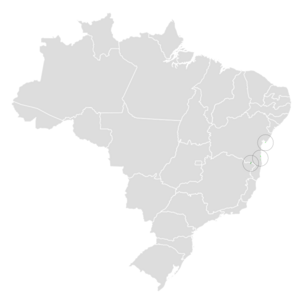Stresemann's bristlefront facts for kids
Quick facts for kids Stresemann's bristlefront |
|
|---|---|
| Conservation status | |
| Scientific classification | |
| Genus: |
Merulaxis
|
| Species: |
stresemanni
|
 |
|
The Stresemann's bristlefront (scientific name: Merulaxis stresemanni) is a very rare bird. It belongs to a group of birds called tapaculos. This special bird lives only in Brazil. It is currently critically endangered, which means it is in great danger of disappearing forever.
Contents
About the Stresemann's Bristlefront
What Kind of Bird Is It?
Scientists think the Stresemann's bristlefront is closely related to another bird, the slaty bristlefront. They are so similar, they might even be the same species! This bird is very hard to find. Scientists have only studied a few birds directly. Most of what we know comes from photos, recordings of their songs, and people seeing them.
What Does This Bird Look Like?
This bird is about 20 cm (7.9 in) long. That's about the length of a standard pencil! It has a medium size and a long tail.
One special thing about this bird is the long, pointed bristles on its forehead. These are like stiff hairs.
- Male birds: They are mostly a dark gray color. Their lower back, tail feathers, and belly are a dark reddish-brown.
- Female birds: They are cinnamon-brown on their back. Their tail is a bit darker. Their underside is a bright cinnamon color.
Where Does the Stresemann's Bristlefront Live?
Its Home in the Forest
The Stresemann's bristlefront lives in subtropical or tropical moist lowland forest. These are warm, wet forests found in low-lying areas.
This bird is found only in the Atlantic forest of Brazil. Specifically, it lives in parts of the states of Minas Gerais and Bahia.
Why Its Home Is in Danger
The biggest threat to this bird is habitat loss. This means the forests where it lives are disappearing. People are cutting down trees to make farms.
The Mata do Passarinho Reserve is a special place. It is the last known area where the Stresemann's bristlefront lives. This reserve has both very old forests (called primary forest) and newer forests (called secondary forest). It's like an island of trees surrounded by farmland.
How Does the Stresemann's Bristlefront Behave?
What Does It Eat?
One Stresemann's bristlefront was seen looking for food on the ground. It also searched on fallen tree trunks. This happened in a drier part of the forest. It has been seen eating insects.
How Does It Build Nests?
The first known nest of a Stresemann's bristlefront was a tunnel. Scientists think this tunnel was about 6 ft (1.8 m) long. The actual nest inside the tunnel was not described.
What Does Its Song Sound Like?
The Stresemann's bristlefront has a unique song. It starts with clicking sounds. Then, it changes into a long, fast trill. Its song is similar to the slaty bristlefront's song. However, the Stresemann's bristlefront sings at a lower pitch. This bird will often sing back if you play its song recording.
Why Is This Bird Critically Endangered?
The Stresemann's bristlefront is one of the rarest birds on Earth. The IUCN (International Union for Conservation of Nature) has listed it as Critically Endangered. This is the highest risk category before extinction.
In 2019, people searched widely for this bird. It was last seen in a tiny piece of forest. This area is now protected as the Mata do Passarinho Reserve.
The IUCN believes that fewer than 50 adult Stresemann's bristlefronts are left. The area where they are known to live is very small, about 35 km2 (14 sq mi). The small amount of forest left is disappearing quickly. Even though this bird is legally protected, it is still very hard to save it.


